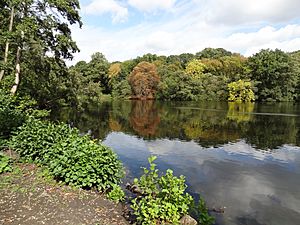Bentley Priory Nature Reserve facts for kids
| Site of Special Scientific Interest | |

Summerhouse Lake
|
|
| Area of Search | Greater London |
|---|---|
| Interest | Biological |
| Area | 55.1 hectares |
| Notification | 1990 |
| Location map | Magic Map |
Bentley Priory Nature Reserve is a very special protected area in Stanmore, London. It's known as a Site of Special Scientific Interest (SSSI) and a Local Nature Reserve. This means it's important for its wildlife and natural features. The reserve covers about 55 hectares (that's like 136 football fields!) and surrounds the historic Bentley Priory house. It's a unique mix of old forests, natural grasslands, bushes, wet areas, streams, and a man-made lake. This kind of natural variety is quite rare in a big city like London.
History of Bentley Priory
The name Bentley Priory comes from a religious building that was here long ago in the Middle Ages. It was an Augustinian priory, which was a type of monastery for canons (a group of priests). This priory stopped existing before the 1530s, when many monasteries were closed down in England during the Dissolution of the Monasteries.
In 1775, a famous architect named Sir John Soane designed a new house called Bentley Priory. It was built just north of where the old priory used to be. A small stream called Edgware Brook ran through the grounds. It was dammed (blocked) to create Summerhouse Lake. This lake was named after a small building by its side, which belonged to Queen Adelaide. She was the wife of King William IV and lived her last years at Bentley Priory in the 1840s.
The house and its grounds were separated later on. The house became RAF Bentley Priory, which was a very important headquarters for Fighter Command during the Second World War. Today, the nature reserve grounds are looked after by the Harrow Nature Conservation Forum. This group is part of the Harrow Heritage Trust, working to protect this amazing natural space.
Exploring the Nature Reserve
The name "Bentley" might come from an old Anglo-Saxon word, "Beonet." This word described a place covered in coarse (rough) grass, which you can still see a lot of in the reserve today. Many parts of the grassland have never been treated with chemicals like fertilisers. This means they are full of different kinds of wild flowers.
- The main types of grass you'll find are common bent, red fescue, and Yorkshire Fog.
- Some of the less common wild flowers include greater burnet, great burnet, and spotted orchid.
- The reserve is also home to many birds, such as the buzzard, spotted flycatcher, and bullfinch.
Bentley Priory has several woods, including one called Heriot Wood. The main tree in this wood is the hornbeam. This type of tree is often found in very old forests, known as ancient woodlands. Heriot Wood might even date back to the end of the last Ice Age, about 11,500 years ago! To the east of the reserve, there's also a private deer park.
The London Loop, a long walking path around London, goes right through Bentley Priory. You can enter the reserve from several roads, including Common Road, Priory Drive, Aylmer Drive, Embry Way, Old Lodge Way, Bentley Way, and Masefield Avenue.

